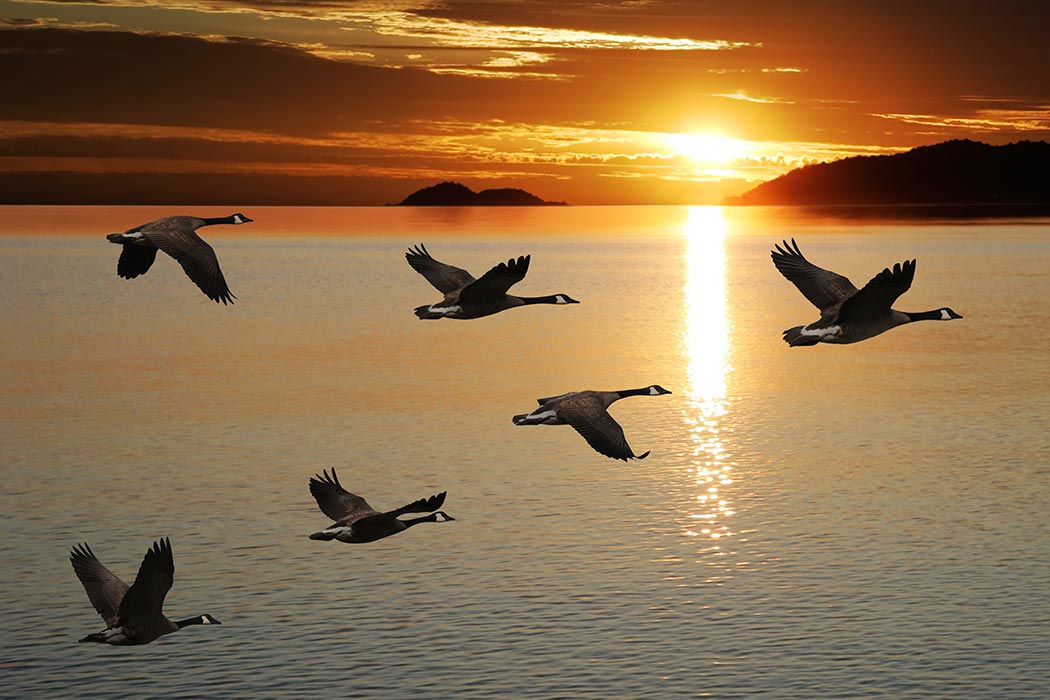Wildlife scientists have learned some fascinating facts about why migratory birds always fly in a v-formation. Some of what they learned can actually teach us a few things about teamwork. Here are seven lessons we can learn and apply from a flock of birds:
- We can fly farther and more efficiently together than we can alone. By flying together in a v-formation, scientists estimate that a flock of birds can fly about 70% farther with the same amount of energy than if each bird flew alone. Birds have learned that they can reach their destination more quickly and with less energy expended when they fly together in formation. The same is true for teams. Teams that share a common direction and goal will get to their destination quicker and with less effort working together versus as a collection of individuals each doing their own thing.
- It’s important for everyone to be able to see where we are going. Why do geese fly in a V-formation versus in single file? One reason is that flying in a V-formation increases the visibility – no matter where they are in the order, every goose in the flock can see what’s happening in front of them. No one wants to fly blindly. Teams don’t work very well if it is just the leader who is looking forward and everyone else is just gazing at the backside of the bird ahead of them. When working as a team, make sure everyone sees the big picture, and is able to see clearly where you are going.
- It requires a great deal more effort and energy to fly alone than it does to fly together. When a bird falls out of formation, it suddenly realizes there is a lot more drag and air resistance flying alone. They quickly flap back into formation, having discovered that the extra energy needed to fly alone wasn’t worth it. Sometimes people playing on teams will drop out of the group and try to accomplish goals on their own. Like the birds, however, they usually discover that it works better to be part of a cohesive team rather than flying alone.
- Everyone’s job is easier if we respect the formation. The leader sets the pace for the whole flock. Fly too fast, and the flock will tire out. Fly too slow, the flock as a whole creates less lift, and it takes needlessly more time and effort to reach their destination. When going long distances, birds in a flock will take turns flying point position. Also, the birds in the front create a forward draft that allows everyone else behind them to fly with less effort. At the same time, the birds in the middle and the back actually help the ones in the front by creating an upward draft that propels the whole flock forward with less effort. The net effect is that even though the geese at the front don’t have the benefit of flying in the draft of the birds ahead of them, their job is easier if the whole flock is flying as one unit behind them. In essence ~ if everyone is keeping pace and flying in formation, everyone’s job is easier. Followership is sometimes just as important as leadership. Everyone has an important role to play to keep the team working cohesively.
- Honking is helpful.Have you ever wondered why geese honk when they fly in formation but not when they fly alone? Honking is how they spur each other on during flight. Similarly, when working on teams, it is important for each team member to communicate regularly with others. Encourage one other! Teams frequently fall apart because of inadequate communication. Constant communication among members is important to keep moving effectively towards a common goal.
- Keep flying tirelessly until you reach your destination. Migrating geese take an arduous journey that can stretch to a round-trip distance of several thousand miles. It is an effort that tests both their physical and mental capabilities. They encounter multiple hazards along the way … physical stresses, food shortages, bad weather, predators, etc. Yet they are relentless in their quest to reach their destination. When a team is working towards a goal, reaching the destination is rarely easy. You are going to run up against challenges along the way. When the going gets tough, fly tirelessly and stay in formation to improve the likelihood you will reach your goal.
- Individual birds sometimes come and go from a flock, but if the flock itself becomes scattered and isn’t able to get back together, it will never reach its destination. If they can’t find another flock, individual birds may end up becoming stranded. They don’t make it to their destination, but they can’t find their way home either. They end up living in the middle of nowhere.
Author’s Note: I recently shared this as a reflection at the start of a meeting with a new client. It is not original to me ~ long ago I heard a variation of it that stuck with me. It came back to me more recently as being particularly appropriate for this new client, since they are still trying to find their “rhythm” as a team. I searched out and cobbled together these thoughts from various sources I found on the web.


